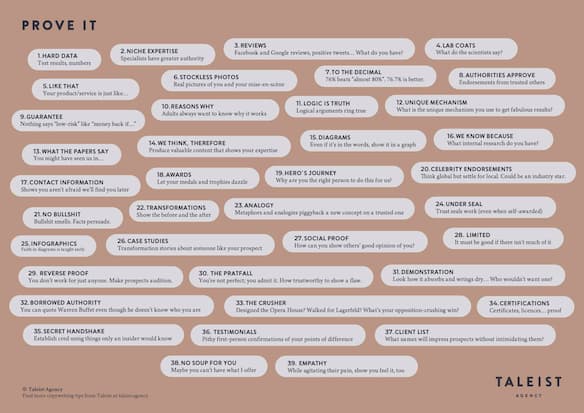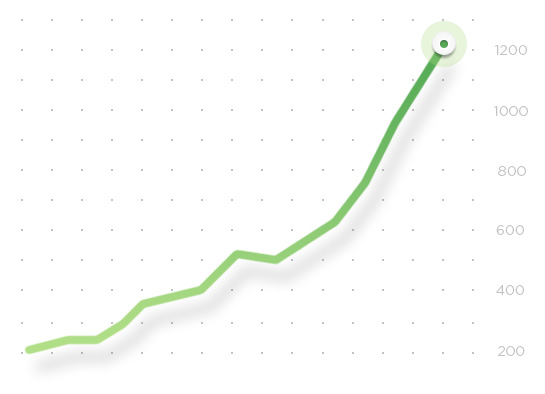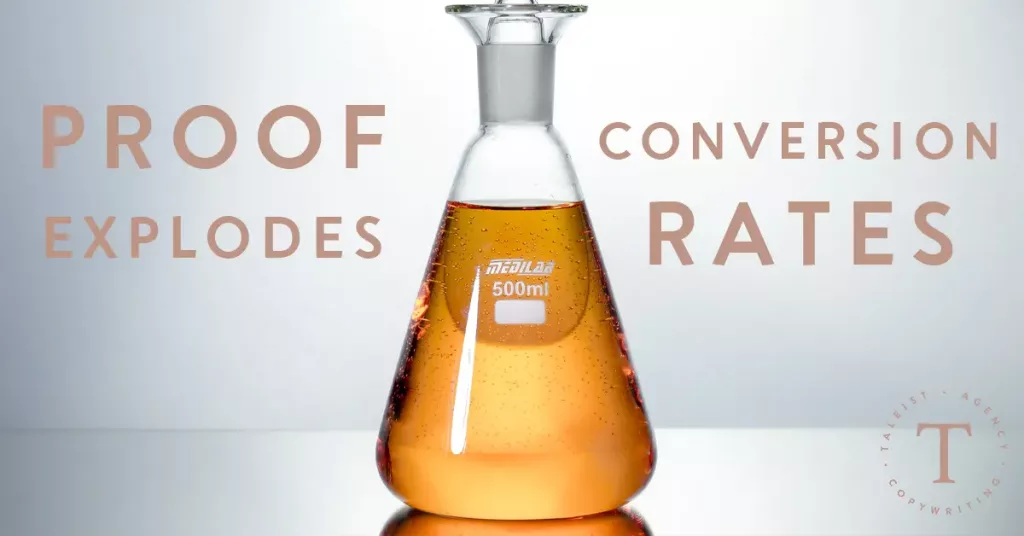Using proof to increase your conversion rate
Updated 19 June 2021
The #1 thing that will improve your conversion rate is PROOF
Most copywriting says things without proving them. As a result, the copywriting converts poorly.
Anyone can say they’re “passionate about customer service”, and thousands upon thousands of lazy businesses say exactly that. But the business with the enviable conversion rate will be the one that proves its commitment to its clients. The winning business will add that its staff were trained by the former director of guest experience at the Four Seasons. The business with the killer conversion rate will display its more than 1,000 five-star reviews on Facebook, and it will offer an unbelievable guarantee that you can cash in should the customer service fall short of your expectations.
As a rule of thumb, you must introduce evidence sufficient to prove anything you claim. If you want a killer conversion rate, you can’t just say; you must back up what you say. However, if you comb through the copywriting on your website or landing page, you’ll soon have a census of dozens of claims wafting through hot air because they are not anchored to proof.
The good news is that you can transform those useless balloons into conversion bullets through the magic of proof.
We’re not talking only about “proof” that a judge would accept. The proof we’re talking about is anything that nudges a prospect across the divide between sceptical and convinced. To help you put a tent pole in your conversion rate, we’ve compiled 39 types of proof, running the gamut from lab tests to metaphors.
How many of our 39 types of copywriting proof you use to optimise your conversion rate?

1. Hard data
Do you have test results or hard numbers? What did that Nobel Prize-winner find when they studied your ingredients?
Science is some of the best proof you can find — unless your audience comprises flat-earthers and anti-vaxxers.
2. Niche expertise
Specialists have greater authority, which means they can close more deals at higher prices. Why? People are reluctant to believe their problems are the same as other people’s problems.
If you offer a program to fill the appointment books of doctors and physiotherapists, each group will doubt you can fill their appointment books. Even though doctors and physios face almost identical problems filling their appointment books are almost identical, you might as well be trying to sell a program to dog handlers and astronauts at the same time.
The answer is to offer two programs — one for doctors and one for physios — even if the content is largely the same. The specialisation will count as proof.
3. Reviews
Other than when specialist knowledge is required, humans trust people who are like them more than anything else. If you are — or you live with — someone who won’t book a hotel before reading a thousand reviews on TripAdvisor, you know what we’re talking about.
So, what Facebook and Google reviews, positive tweets or other reviews can you include in your marketing?
4. Lab coats
What do the scientists say? Quoting someone with a Ph.D will go a long way. Even just the sight of a lab coat can melt objections — why do you think make-up companies dress their sales people in white coats? One study showed that non-science students who took an exam wearing a lab coat outperformed the students who didn’t.
5. Like that
Ever heard someone convince another person to try a strange food by saying it “tastes like chicken”?
If your product or service is in any way unfamiliar, you can throw a ladder over that obstacle by comparing your product or service to something familiar to the prospect. “It’s the Uber for…” “It’s like skiing but on an surfboard…”
6. Stockless photos
When we were growing up, betting shops and adult stores had frosted windows. It made them intimidating to enter because we couldn’t see what was behind. Stock photos are the equivalent of that frosted glass. It’s like you’re hiding something we’re not supposed to see. Real pictures of you and your mise-en-scène build trust because you’re not hiding anything.
7. To the decimal
When it comes to proof, 76% beats “almost 80%”. 76.7% is better. “Almost 80%” sounds like a guess, as does a round number. 76.7% sounds like someone who knows what they’re doing has had the callipers out. So if you have good data, don’t ruin it by rounding.
8. Authorities approve
Endorsements from trusted others are a fantastic shortcut for persuasion. That smart person thinks this is a good idea, so I don’t have to think about it too much myself. Who am I to question the British Medical Association, the Heart Foundation or the Guild of Electrical Engineers?
9. Guarantee
Nothing says “low-risk” like “money back if…” And guarantees scream confidence in yourself. The bolder the guarantee, the greater the proof. Haven’t you ever been swayed to buy the frying pan with the 10-year guarantee over the indistinguishable one whose makers weren’t backing themselves to the same degree?
10. Reasons why
Adults always want to know why something works, so there’s proof in that why. This is why creams and potions are sold as the only one that has polysyllabic-invented-ingredient. That polysyllabic-invented-ingredient is supposedly the reason why HyperDuper Moisturising Lotion works. The ingredient is the proof, even if you won’t find polysyllabic-invented-ingredient in any research paper.
11. Logic is truth
Logical arguments ring true, and if you don’t have a logical argument, one that sounds logical will do. Reindeer live a long time. Reindeer drink their own urine. So you should drink your own urine if you want to live a long time. Thirsty yet?
Urophagia might not be a great example, but take a moment to listen to the next professional salesperson trying to sell you something. It won’t take long for the salesperson to raise the curtain on the performance of a logical-sounding argument.
12. Unique mechanism
KFC had its 7 herbs and spices. Coca-Cola has its secret formula…
Humans love the suggestion that someone has refined their offering into a machine that guarantees consistent results. Every guru has their 9 steps or 12-week program. Taleist has our 7-layer copywriting process.
What is the unique mechanism you use to get fabulous results and transform the lives of your prospects? Codifying might not change what you do every day, but codifying the everyday into a unique mechanism creates proof that you can deliver.
13. What the papers say
You might have seen us in… It works. We have an innate belief that it’s hard to get yourself into the newspaper or on TV because the media rigorously vets the businesses and people it features. For that reason, we’re impressed to know you’ve been mentioned in the newspaper or on TV. It’s why so many websites, including ours, have a banner showing the logos of the media outlets that have mentioned them. (If you want to use media mentions as proof, download our free guide to getting your business in the media with a press release.)
14. We think, therefore
Blog posts, white papers, thoughtful LinkedIn posts… It might take only one piece or it might be a cumulative effect from consistently sharing valuable content, but you can prove your expertise with content.
15. Diagrams
Even if it’s in the words, show it in a graph and you’ll be amazed at the results.

Doesn’t this graph look convincing? But it doesn’t say anything at all. Neither axis is marked. Who knows what the graph is “measuring”, but next to copy promising results, it works. (Our preference, however, is for graphs that show something real, not psychological tricks like this.)
16. We know because
What internal research do you have? You might not have external research or third-party endorsements but have you conducted your own research to use for proof?
17. Contact information
Including contact information proves you aren’t afraid we’ll find you later, although you undermine yourself if that contact information seems more burner-phone than bricks-and-mortar, so a full address where you can, not a P.O. box, a landline not a mobile, etc.
18. Awards
Let your medals and trophies dazzle.
19. Hero’s journey
Why are you the right person to do this for us? Tell us your story. How did you get here? What did you learn on the way? And how is that going to solve our problems.
20. Celebrity endorsements
Ever wondered why anyone would buy a vitamin because Tiger Woods takes it? Us, too, but those endorsements work. Think global but settle for local. You might not get Will Smith, but you might get endorsement from a star in your industry or a big noise in your city.
21. No bullshit
Bullshit smells. Facts persuade.
22. Transformations
Show the before and the after and you’ll have them hooked — crooked teeth become straight, yellow teeth become white, XL becomes XS…
23. Analogy
Tropicana orange juice was “your daily ray of sunshine”, a metaphor that conjures the idea of health, vitality and the power of nature. Doesn’t that sound convincing? Copywriters offer to send leads down a greased chute or to create a flood of work. Metaphors send your brain on a detour around reasoning, so they work.
What’s a metaphor for what you do?
24. Under seal
Trust seals work (even when self-awarded).
25. Infographics
Faith in diagrams is taught early. Combining text and visuals is not only fast, it triggers the same neurons that love a logical argument. Here’s one of ours, for instance — an infographic on writing press releases.
26. Case studies
A case study is not the same as a testimonial. A case study is a story of how someone like your prospect transformed because they worked with you or your product.
For more, read our guide to writing case studies that sell.
27. Social proof
Social proof is one of the most potent of all the proofs. How can you show others’ good opinion of you?
28. Limited
The human brain is alert for scarcity. When something is limited, we want it.
29. Reverse proof
You don’t work for just anyone. Make prospects audition. Needy businesses ask if they’re good enough for their prospects. Successful businesses hint that their prospects might not be good enough, and if those prospects are good enough, they should consider themselves lucky.
30. The pratfall
You’re not perfect; you admit it. How trustworthy to show a flaw. It’s called the pratfall effect because of the studies that show we like someone (and find them more credible) after they make a small mistake, like tripping when they walk in the room.
31. Demonstration
Look how it absorbs and wrings dry… Who wouldn’t want one? If you can show your product working, do it.
32. Borrowed authority
You can quote Warren Buffet talking on a topic related to what you do, even though he doesn’t know who you are.
33. The Crusher
Designed the Opera House? Walked for Lagerfeld? If your prospective tennis coach won Wimbledon, what more do you need to know before you hire her to improve your baseline game?
What’s your opposition-crushing win?
34. Certifications
Certificates, licences… proof. If you have qualifications, use them. Just make sure they’re relevant. Do you care if your real estate agent has a bachelors in geology? But you do care that your accountant is qualified and your psychologist is licensed.
35. Secret handshake
Prove your credibility by mentioning things only an insider would know, but use a light touch. You don’t want a website spread thick with jargon, but the right insider term at the right time is like a key in a lock.
36. Testimonials
A good testimonial is a pithy first-person confirmation of your points of difference. The best testimonials don’t just say you’re brilliant, they address the objections of your prospects. Prospects worried you won’t deliver on time? Have your testimonials say you will.
37. Client list
What names will impress prospects without intimidating them? Ideally, you want brands like your prospects or brands they aspire to be, but you have to be careful that you don’t put off your ideal client because they think they’re not big enough or successful enough to work with you.
38. No soup for you
In copywriting, “takeaway language” is language that suggests you might take away the offer. “This product is not for you if…” Not only do we want what we can’t have, but how confident must you be if you don’t have to resort to the hard sell; in fact you might not sell to me at all.
39. Empathy
While agitating their pain, show you feel it, too. When you show that you understand me, I’m more likely to believe you can help me.
How to use your proof in a high-converting landing page
Persuasive writing is 100% the fastest way to take charge of your conversion rate. So why waste thousands of dollars of advertising by sending traffic to an unconvincing landing page?
If you’re sending traffic to your website and it’s not converting at the rate you hoped for, Taleist can help.
Our copywriters can review your landing page, rewrite your landing page or show you how to write your own high-converting landing page following The Landing Page Template™.
An improved conversion rate is only a click away.
